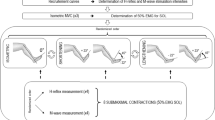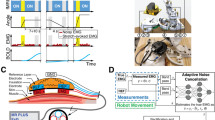Abstract
WITHIN the past decade, the use of electronic methods has laid bare much of the mechanism underlying the myotatic, or stretch, reflex of mammalian striated muscle. Outstanding among these advances are Lloyd's demonstration of the monosynaptic nature of the myotatic reflex pathway, and his disclosure that fibres of large diameter (Group I fibres) constitute the afferent limb of this reflex arc1. However, the specific receptor organ responsible for initiating the stretch reflex has so far eluded positive identification, though the balance of evidence suggests muscle spindles rather than Golgi tendon organs2.
This is a preview of subscription content, access via your institution
Access options
Subscribe to this journal
Receive 51 print issues and online access
$199.00 per year
only $3.90 per issue
Buy this article
- Purchase on Springer Link
- Instant access to full article PDF
Prices may be subject to local taxes which are calculated during checkout
Similar content being viewed by others
References
Lloyd, D. P. C., J. Neurophysiol., 6, 111 (1943); 6, 293 (1943); 6, 317 (1943).
Barker, D., Quart. J. Micr. Sci., 89, 143 (1948).
Szentagothai, J., J. Neurophysiol., 11, 445 (1948).
Rioch, J. McK., and Lambert, E. F., Amer. J. Physiol., 108, 50 (1934).
Matthews, B. H. C., J. Physiol., 78, 1 (1933).
Author information
Authors and Affiliations
Rights and permissions
About this article
Cite this article
McINTYRE, A. Afferent Limb of the Myotatic Reflex Arc. Nature 168, 168–169 (1951). https://doi.org/10.1038/168168a0
Issue Date:
DOI: https://doi.org/10.1038/168168a0
This article is cited by
-
Evoked potentials and brain stem reflexes
Neurosurgical Review (1985)
-
Human phasic reflex response to parameters of a mechanical stimulus as an index of muscle-spindle sensitivity
Medical & Biological Engineering (1973)
-
Electromyogram and myogram responses under pre-strain conditions in normal humans as an index of fusimotor sensitization of muscle spindles
Medical & Biological Engineering (1972)
-
Relationship Between the Electromyogram and the Force of the Isometric Reflex Response of Normal Human Subjects
Nature (1965)
Comments
By submitting a comment you agree to abide by our Terms and Community Guidelines. If you find something abusive or that does not comply with our terms or guidelines please flag it as inappropriate.



